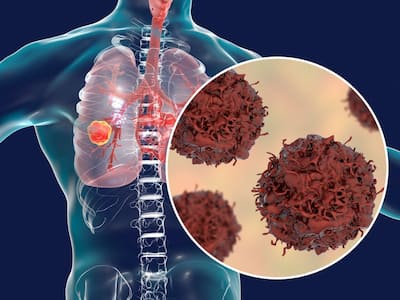
By examining the characteristics and key differences of these types of lung cancers, patients and healthcare professionals can make informed decisions regarding treatment options.
Lung cancer is one of the most common types of cancer worldwide, accounting for a significant number of cancer-related deaths. It is a disease caused by uncontrolled cell division in your lungs. Your cells naturally proliferate and create new duplicates of themselves. However, occasionally they experience modifications (mutations) that lead them to continue producing more of themselves when they shouldn’t. Uncontrolled cell division caused by damage results in tissue tumours, which eventually prevent your organs from functioning properly.
In this article, we take a close look at the two main types of lung cancer – Non-Small Cell Lung Cancer (NSCLC) and Small Cell Lung Cancer (SCLC). To help us understand the techniques by which one can easily spot the symptoms, we have Dr Arun Pandey, Sr. Consultant & Head – Surgical Oncology, Asian Hospital Faridabad.
Non-Small Cell Lung Cancer (NSCLC)
Non-Small Cell Lung Cancer (NSCLC) accounts for approximately 85% of all lung cancer cases, making it the most prevalent type. This type of lung cancer typically grows and spreads more slowly than SCLC. Within NSCLC, there are three main subtypes, each with distinct characteristics and targeted treatment approaches:
Adenocarcinoma
This subtype is the most common among non-smokers and former smokers, as well as the most prevalent in women. Adenocarcinoma often develops in the outer regions of the lungs and can metastasize to distant organs.
Squamous Cell Carcinoma
This type of NSCLC commonly originates in the central airways of the lungs. It is strongly associated with a history of smoking. Early detection and treatment are crucial for better outcomes.
Large Cell Carcinoma
Large cell carcinoma is the least common subtype of NSCLC. It is characterized by its rapid growth and a tendency to spread to distant sites early in its development.
Small Cell Lung Cancer (SCLC)
Small Cell Lung Cancer (SCLC), also known as oat cell carcinoma, accounts for approximately 15% of all lung cancer cases. Unlike NSCLC, SCLC is more aggressive and tends to grow and spread rapidly. It is strongly associated with smoking, and its early detection is challenging due to its rapid progression. SCLC is typically classified into two stages: limited-stage and extensive stage.
Limited-Stage SCLC
In this stage, the cancer is confined to one lung and nearby lymph nodes, allowing for a more targeted approach to treatment.
READ RELATED: 10 Unhealthiest Store-Bought Cookie Doughs To Avoid
Extensive-Stage SCLC
At this stage, the cancer has spread extensively beyond one lung and nearby lymph nodes, making treatment more challenging.
Key Differences Between NSCLC and SCLC
Growth Rate: NSCLC grows and spreads more slowly compared to the aggressive and rapid growth of SCLC.
Prevalence: NSCLC is the most common type, accounting for about 85% of lung cancer cases, while SCLC constitutes around 15% of cases.
Smoking Association: SCLC is strongly associated with smoking, while NSCLC may also occur in non-smokers and former smokers.
Understanding the distinctions between Non-Small Cell Lung Cancer (NSCLC) and Small Cell Lung Cancer (SCLC) is crucial for early diagnosis and developing personalized treatment plans. Early detection and a combination of surgery & targeted therapies can significantly improve patient outcomes, emphasizing the importance of regular screenings and timely medical intervention. Through ongoing research and advancements in medical technology, we can hope for improved treatment options and enhanced survival rates for lung cancer patients in the future.
Total Wellness is now just a click away.
Follow us on
Don’t Miss Out on the Latest Updates.
Subscribe to Our Newsletter Today!
window.addEventListener(‘load’, (event) => {
$(‘#commentbtn’).on(“click”,function(){
(function(d, s, id) { var js, fjs = d.getElementsByTagName(s)[0]; if (d.getElementById(id)) return; js = d.createElement(s); js.id = id; js.src = “//connect.facebook.net/en_US/sdk.js#xfbml=1&version=v2.3”; fjs.parentNode.insertBefore(js, fjs);}(document, ‘script’, ‘facebook-jssdk’));
$(“.cmntbox”).toggle();
});
});








